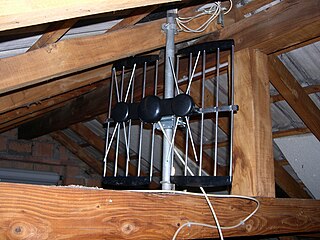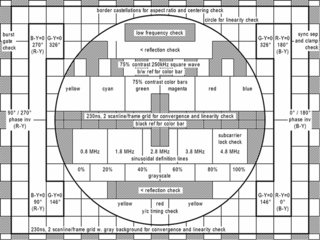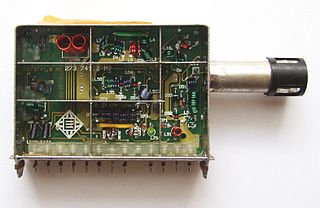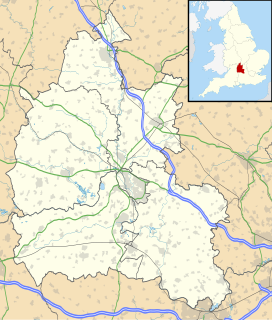Related Research Articles

Very high frequency (VHF) is the ITU designation for the range of radio frequency electromagnetic waves from 30 to 300 megahertz (MHz), with corresponding wavelengths of ten meters to one meter. Frequencies immediately below VHF are denoted high frequency (HF), and the next higher frequencies are known as ultra high frequency (UHF).

Citizens band radio, used in many countries, is a land mobile radio system, a system allowing short-distance person-to-person bidirectional voice communication between individuals, using two way radios operating on 40 channels near 27 MHz (11 m) in the high frequency band. Citizens band is distinct from other personal radio service allocations such as FRS, GMRS, MURS, UHF CB and the Amateur Radio Service. In many countries, CB operation does not require a license, and it may be used for business or personal communications. Like many other land mobile radio services, multiple radios in a local area share a single frequency channel, but only one can transmit at a time. The radio is normally in receive mode to receive transmissions of other radios on the channel; when a user wants to talk they press a "push to talk" button on their radio, which turns on their transmitter. Users on a channel must take turns talking. Transmitter power is limited to 4 watts in the US and the EU. CB radios have a range of about 3 to 20 miles, depending on terrain, for line of sight communication; however, various radio propagation conditions may intermittently allow communication over much greater distances.

Ultra high frequency (UHF) is the ITU designation for radio frequencies in the range between 300 megahertz (MHz) and 3 gigahertz (GHz), also known as the decimetre band as the wavelengths range from one meter to one tenth of a meter. Radio waves with frequencies above the UHF band fall into the super-high frequency (SHF) or microwave frequency range. Lower frequency signals fall into the VHF or lower bands. UHF radio waves propagate mainly by line of sight; they are blocked by hills and large buildings although the transmission through building walls is strong enough for indoor reception. They are used for television broadcasting, cell phones, satellite communication including GPS, personal radio services including Wi-Fi and Bluetooth, walkie-talkies, cordless phones, and numerous other applications.
Citizens band radio is a system of short-distance radio communications between individuals on a selection of 40 channels within the 27-MHz band. In the United Kingdom, CB radio was first legally introduced in 1981, but had been used illegally for some years prior.

Terrestrial television is a type of television broadcasting in which the television signal is transmitted by radio waves from the terrestrial (Earth-based) transmitter of a television station to a TV receiver having an antenna. The term terrestrial is more common in Europe and Latin America, while in the United States it is called broadcast or over-the-air television (OTA). The term "terrestrial" is used to distinguish this type from the newer technologies of satellite television, in which the television signal is transmitted to the receiver from an overhead satellite, cable television, in which the signal is carried to the receiver through a cable, and Internet Protocol television, in which the signal is received over an Internet stream or on a network utilizing the Internet Protocol. Terrestrial television stations broadcast on television channels with frequencies between about 52 and 600 MHz in the VHF and UHF bands. Since radio waves in these bands travel by line of sight, reception is limited by the visual horizon to distances of 40–60 miles (64–97 km).

The Family Radio Service (FRS) is an improved walkie-talkie radio system authorized in the United States since 1996. This personal radio service uses channelized frequencies around 462 and 467 MHz in the ultra high frequency (UHF) band. It does not suffer the interference effects found on citizens' band (CB) at 27 MHz, or the 49 MHz band also used by cordless telephones, toys, and baby monitors. FRS uses frequency modulation (FM) instead of amplitude modulation (AM). Since the UHF band has different radio propagation characteristics, short-range use of FRS may be more predictable than the more powerful license-free radios operating in the HF CB band.

Amateur television (ATV) is the transmission of broadcast quality video and audio over the wide range of frequencies of radio waves allocated for radio amateur (Ham) use. ATV is used for non-commercial experimentation, pleasure, and public service events. Ham TV stations were on the air in many cities before commercial television stations came on the air. Various transmission standards are used, these include the broadcast transmission standards of NTSC in North America and Japan, and PAL or SECAM elsewhere, utilizing the full refresh rates of those standards. ATV includes the study of building of such transmitters and receivers, and the study of radio propagation of signals travelling between transmitting and receiving stations.
The radio spectrum is the part of the electromagnetic spectrum with frequencies from 30 hertz to 300 GHz. Electromagnetic waves in this frequency range, called radio waves, are widely used in modern technology, particularly in telecommunication. To prevent interference between different users, the generation and transmission of radio waves is strictly regulated by national laws, coordinated by an international body, the International Telecommunication Union (ITU).

A tuner is a subsystem that receives radio frequency (RF) transmissions like radio broadcasts and converts the selected carrier frequency and its associated bandwidth into a fixed frequency that is suitable for further processing, usually because a lower frequency is used on the output. Broadcast FM/AM transmissions usually feed this intermediate frequency (IF) directly into a demodulator that convert the radio signal into audio-frequency signals that can be fed into an amplifier to drive a loudspeaker.

PMR446 is a licence exempt service in the UHF radio frequency band and is available for business and personal use in most countries throughout the European Union.

FM broadcasting is a method of radio broadcasting using frequency modulation (FM). Invented in 1933 by American engineer Edwin Armstrong, wide-band FM is used worldwide to provide high fidelity sound over broadcast radio. FM broadcasting is capable of higher fidelity—that is, more accurate reproduction of the original program sound—than other broadcasting technologies, such as AM broadcasting or DAB radio. Therefore, FM is used for most broadcasts of music. FM radio stations use the very high frequency range of radio frequencies.
A broadcast transmitter is a transmitter used for broadcasting, an electronic device which radiates radio waves modulated with information content intended to be received by the general public. Examples are a radio broadcasting transmitter which transmits audio (sound) to broadcast radio receivers (radios) owned by the public, or a television transmitter, which transmits moving images (video) to television receivers (televisions). The term often includes the antenna which radiates the radio waves, and the building and facilities associated with the transmitter. A broadcasting station consists of a broadcast transmitter along with the production studio which originates the broadcasts. Broadcast transmitters must be licensed by governments, and are restricted to specific frequencies and power levels. Each transmitter is assigned a unique identifier consisting of a string of letters and numbers called a callsign, which must be used in all broadcasts.

The Oxford transmitting station is a broadcasting and telecommunications facility, situated on land 129.5 metres (425 ft) above Ordnance Datum to the north east of the city of Oxford, in Oxfordshire, England. It has a guyed steel lattice mast which is 154.4 metres (507 ft) in height to the top of the main steel structure. The UHF television antenna, which consist of a vertical array of transmitting panels, is mounted above the steel structure. The total height of the mast to the top of this UHF antenna is 165.7 metres (544 ft). It is owned and operated by Arqiva.

A broadcast relay station, also known as a satellite station, relay transmitter, broadcast translator (U.S.), re-broadcaster (Canada), repeater or complementary station (Mexico), is a broadcast transmitter which repeats the signal of a radio or television station to an area not covered by the originating station. It expands the broadcast range of a television or radio station beyond the primary signal's original coverage or improves service in the original coverage area. The stations may be used to create a single-frequency network. They may also be used by an FM or AM radio station to establish a presence on the other band.

Citizens band radio is a system of short-distance radio communications between individuals on a selection of channels within the 27-MHz band. In India, this frequency band extends from 26.957 MHz to 27.283 MHz. There are several different channel plans in use. Citizens band is distinct from the Family Radio Service, GMRS, Multi-Use Radio Service and amateur radio (Ham). In many countries CB operation does not require a license, and it may be used for business or personal communications. Like many other two-way radio services, any citizens band channel is shared by many users. Only one station may transmit in a channel at a time; other stations must listen and wait for the shared channel to be available. Also, the system works in half-duplex mode, which means we may transmit and receive information, but not both at the same time.
Tropospheric propagation describes electromagnetic propagation in relation to the troposphere. The service area from a VHF or UHF radio transmitter extends to just beyond the optical horizon, at which point signals start to rapidly reduce in strength. Viewers living in such a "deep fringe" reception area will notice that during certain conditions, weak signals normally masked by noise increase in signal strength to allow quality reception. Such conditions are related to the current state of the troposphere.

A personal radio service is any system that allows individual to operate radio transmitters and receivers for personal purposes with minimal or no special license or individual authorization. Personal radio services exist around the world and typically use light-weight walkie talkie portable radios. The power output, antenna size, and technical characteristics of the equipment are set by regulations in each country. Many regions have standardized personal radio service rules to allow travelers from one country to use their equipment in another country. Examples of standardized services include PMR446 and FM Citizens Band Radio (CB) in the EU and several other countries/regions. 26–27 MHz CB radio is the oldest personal radio service and is used in nearly every country worldwide, with many countries and regions copying the United States 40-channel frequency plan. In many countries, CB radio is less popular due to the availability of other personal radio services that offer shorter antennas, better protection from noise and interference.
The Pan-American television frequencies are different for terrestrial and cable television systems. Terrestrial television channels are divided into two bands: the VHF band which comprises channels 2 through 13 and occupies frequencies between 54 through 216 MHz, and the UHF band, which comprises channels 14 through 51 and occupies frequencies between 470 and 700 MHz. These bands are different enough in frequency that they often require separate antennas to receive, and separate tuning controls on the television set. The VHF band is further divided into two frequency ranges: VHF low band between 54 and 88 MHz, containing channels 2 through 6, and VHF high band between 174 and 216 MHz, containing channels 7 through 13. The wide spacing between these frequency bands is responsible for the complicated design of rooftop TV antennas. The UHF band has higher noise and greater attenuation, so higher gain antennas are often required for UHF.
Public Radio Service(PRS) is a walkie-talkie personal radio service service in China. People can use it without licenses. It use 409 MHz. It is also known as PRS409. It is similar to the American Family Radio Service (FRS) and PMR446 in the European Union.
References
- ↑ "Post- och telestyrelsens föreskrifter om undantag från tillståndsplikt för användning av vissa radiosändare". PTS.
- 1 2 http://www.lovdata.no/cgi-wift/ldles?ltdoc=/for/ff-20120119-0077.html#40 Norwegian regulation on general permission for use of frequencies $40 (2) [in Norwegian]
- ↑ "KDR 444 cleared for use across the European Union - a Freedom of Information request to Office of Communications". WhatDoTheyKnow. 2016-09-28. Retrieved 2016-10-19.
| This article related to radio communications is a stub. You can help Wikipedia by expanding it. |